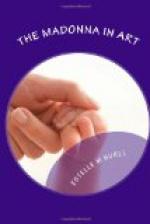The Madonna in Adoration is, properly speaking, a fifteenth century subject. It belongs primarily to that most mystic of all schools of art, the Umbrian, centering in the town of Perugia. Nowhere else was painting so distinctly an adjunct of religious services, chiefly designed to aid the worshipper in prayer and contemplation.
As an exponent of the typical qualities of the Perugian school stands the artist who is known by its name, Perugino. His favorite subject is the Madre Pia, and his best picture of the kind is the Madonna of the National Gallery. Having once seen her here, the traveller recognizes her again and again in other galleries, in the many replicas of this charming composition. The Madonna kneels in the foreground, adoring with folded hands the child, who is supported in a sitting posture on the ground, by a guardian angel. The Virgin’s face is full of fervent and exalted emotion.
Perugino had no direct imitator of his Madre Pia, but his Bolognese admirer Francia treated the subject in a way that readily suggests the source of his inspiration. His Madonna of the Rose Garden in Munich instantly recalls Perugino. The artist has, however, chosen a novel motif in representing the moment when the Virgin is just sinking on her knees, as if overcome by emotion.
Between the Umbrian school and the Florentine, a reciprocal influence was exerted. If the latter taught the former many secrets of composition and technical execution, the Umbrians in turn imparted something of their mysticism to their more matter-of-fact neighbors. While the Umbrian school of the fifteenth century was occupied with the Madre Pia, Florence also was devoted to the same subject. Sculpture led the race, and in the front ranks was Luca della Robbia, founder of the school which bears his family name.
Beginning as a worker in marble, his inventive genius presently wrought out a style of sculpture peculiarly his own. This was the enamelled terra-cotta bas-relief showing pure white figures against a background of pale blue. They were made chiefly in circular medallions, lunettes, and tabernacles, and were scattered throughout the churches and homes of Tuscany.
Associated with Luca in his work was his nephew Andrea, who, in turn, had three sculptor sons, Giovanni, Girolamo, and Luca II. So great was the demand for their ware that the Della Robbia studios became a veritable manufactory from which hundreds of pieces went forth. Of these, a goodly number represent the Madonna in Adoration. While it is difficult to trace every one of these with absolute correctness to its individual author, the majority seem to be by Andrea, who, as it would appear, had a special fondness for the subject. It must be acknowledged that the nephew is inferior to his uncle in his ideal of the Virgin, less original than Luca in his conceptions, and less noble in his results. His work, notwithstanding, has many charming




